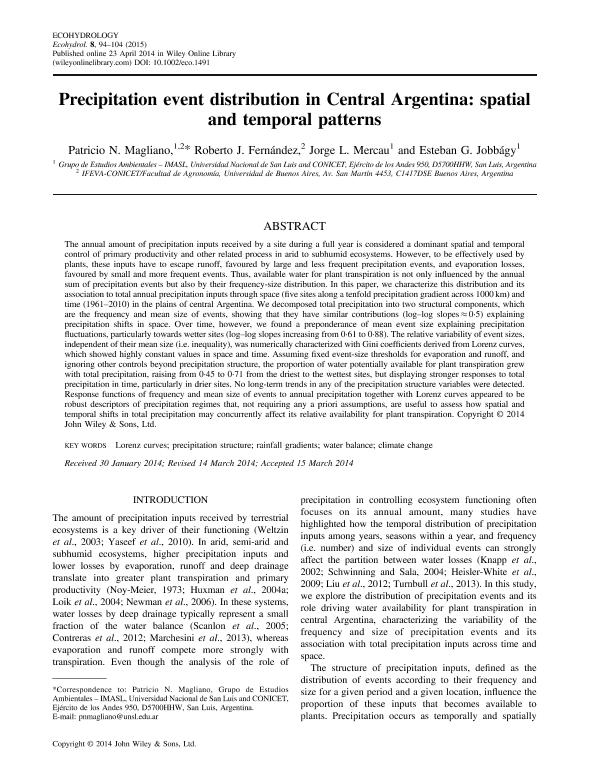Mostrar el registro sencillo del ítem
dc.contributor.author
Magliano, Patricio Nicolás

dc.contributor.author
Fernandez, Roberto Julio

dc.contributor.author
Mercau, Jorge Luis

dc.contributor.author
Jobbagy Gampel, Esteban Gabriel

dc.date.available
2016-02-04T20:31:23Z
dc.date.issued
2015-01
dc.identifier.citation
Magliano, Patricio Nicolás; Fernandez, Roberto Julio; Mercau, Jorge Luis; Jobbagy Gampel, Esteban Gabriel; Precipitation event distribution in central argentina: Spatial and temporal patterns; John Wiley & Sons Inc; Ecohydrology; 8; 1; 1-2015; 94-104
dc.identifier.issn
1936-0584
dc.identifier.uri
http://hdl.handle.net/11336/4032
dc.description.abstract
The annual amount of precipitation inputs received by a site during a full year is considered a dominant spatial and temporal control of primary productivity and other related process in arid to subhumid ecosystems. However, to be effectively used by plants, these inputs have to escape runoff, favoured by large and less frequent precipitation events, and evaporation losses, favoured by small and more frequent events. Thus, available water for plant transpiration is not only influenced by the annual sum of precipitation events but also by their frequency-size distribution. In this paper, we characterize this distribution and its association to total annual precipitation inputs through space (five sites along a tenfold precipitation gradient across 1000km) and time (1961-2010) in the plains of central Argentina. We decomposed total precipitation into two structural components, which are the frequency and mean size of events, showing that they have similar contributions (log-log slopes≈0·5) explaining precipitation shifts in space. Over time, however, we found a preponderance of mean event size explaining precipitation fluctuations, particularly towards wetter sites (log-log slopes increasing from 0·61 to 0·88). The relative variability of event sizes, independent of their mean size (i.e. inequality), was numerically characterized with Gini coefficients derived from Lorenz curves, which showed highly constant values in space and time. Assuming fixed event-size thresholds for evaporation and runoff, and ignoring other controls beyond precipitation structure, the proportion of water potentially available for plant transpiration grew with total precipitation, raising from 0·45 to 0·71 from the driest to the wettest sites, but displaying stronger responses to total precipitation in time, particularly in drier sites. No long-term trends in any of the precipitation structure variables were detected. Response functions of frequency and mean size of events to annual precipitation together with Lorenz curves appeared to be robust descriptors of precipitation regimes that, not requiring any a priori assumptions, are useful to assess how spatial and temporal shifts in total precipitation may concurrently affect its relative availability for plant transpiration.
dc.format
application/pdf
dc.language.iso
eng
dc.publisher
John Wiley & Sons Inc

dc.rights
info:eu-repo/semantics/openAccess
dc.rights.uri
https://creativecommons.org/licenses/by-nc-sa/2.5/ar/
dc.subject
CLIMATE CHANGE
dc.subject
LORENZ CURVES
dc.subject
PRECIPITATION STRUCTURE
dc.subject
RAINFALL GRADIENTS
dc.subject
WATER BALANCE
dc.subject.classification
Investigación Climatológica

dc.subject.classification
Ciencias de la Tierra y relacionadas con el Medio Ambiente

dc.subject.classification
CIENCIAS NATURALES Y EXACTAS

dc.title
Precipitation event distribution in central argentina: Spatial and temporal patterns
dc.type
info:eu-repo/semantics/article
dc.type
info:ar-repo/semantics/artículo
dc.type
info:eu-repo/semantics/publishedVersion
dc.date.updated
2016-03-30 10:35:44.97925-03
dc.journal.volume
8
dc.journal.number
1
dc.journal.pagination
94-104
dc.journal.pais
Estados Unidos

dc.journal.ciudad
Hoboken
dc.description.fil
Fil: Magliano, Patricio Nicolás. Consejo Nacional de Investigaciones Científicas y Técnicas. Centro Científico Tecnológico Conicet - San Luis. Instituto de Matemática Aplicada de San Luis "Prof. Ezio Marchi". Universidad Nacional de San Luis. Facultad de Ciencias Físico, Matemáticas y Naturales. Instituto de Matemática Aplicada de San Luis "Prof. Ezio Marchi"; Argentina. Consejo Nacional de Investigaciones Científicas y Técnicas. Oficina de Coordinación Administrativa Parque Centenario. Instituto de Investigaciones Fisiológicas y Ecológicas Vinculadas a la Agricultura. Universidad de Buenos Aires. Facultad de Agronomía. Instituto de Investigaciones Fisiológicas y Ecológicas Vinculadas a la Agricultura; Argentina
dc.description.fil
Fil: Fernandez, Roberto Julio. Consejo Nacional de Investigaciones Científicas y Técnicas. Oficina de Coordinación Administrativa Parque Centenario. Instituto de Investigaciones Fisiológicas y Ecológicas Vinculadas a la Agricultura. Universidad de Buenos Aires. Facultad de Agronomía. Instituto de Investigaciones Fisiológicas y Ecológicas Vinculadas a la Agricultura; Argentina
dc.description.fil
Fil: Mercau, Jorge Luis. Consejo Nacional de Investigaciones Científicas y Técnicas. Centro Científico Tecnológico Conicet - San Luis. Instituto de Matemática Aplicada de San Luis "Prof. Ezio Marchi". Universidad Nacional de San Luis. Facultad de Ciencias Físico, Matemáticas y Naturales. Instituto de Matemática Aplicada de San Luis "Prof. Ezio Marchi"; Argentina
dc.description.fil
Fil: Jobbagy Gampel, Esteban Gabriel. Consejo Nacional de Investigaciones Científicas y Técnicas. Centro Científico Tecnológico Conicet - San Luis. Instituto de Matemática Aplicada de San Luis "Prof. Ezio Marchi". Universidad Nacional de San Luis. Facultad de Ciencias Físico, Matemáticas y Naturales. Instituto de Matemática Aplicada de San Luis "Prof. Ezio Marchi"; Argentina
dc.journal.title
Ecohydrology

dc.relation.alternativeid
info:eu-repo/semantics/altIdentifier/url/http://onlinelibrary.wiley.com/doi/10.1002/eco.1491/abstract
dc.relation.alternativeid
info:eu-repo/semantics/altIdentifier/doi/http://dx.doi.org/10.1002/eco.1491
Archivos asociados
